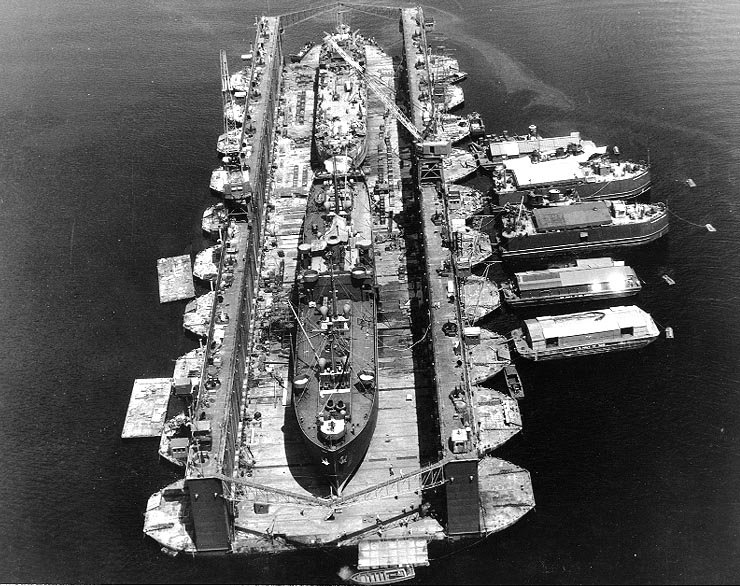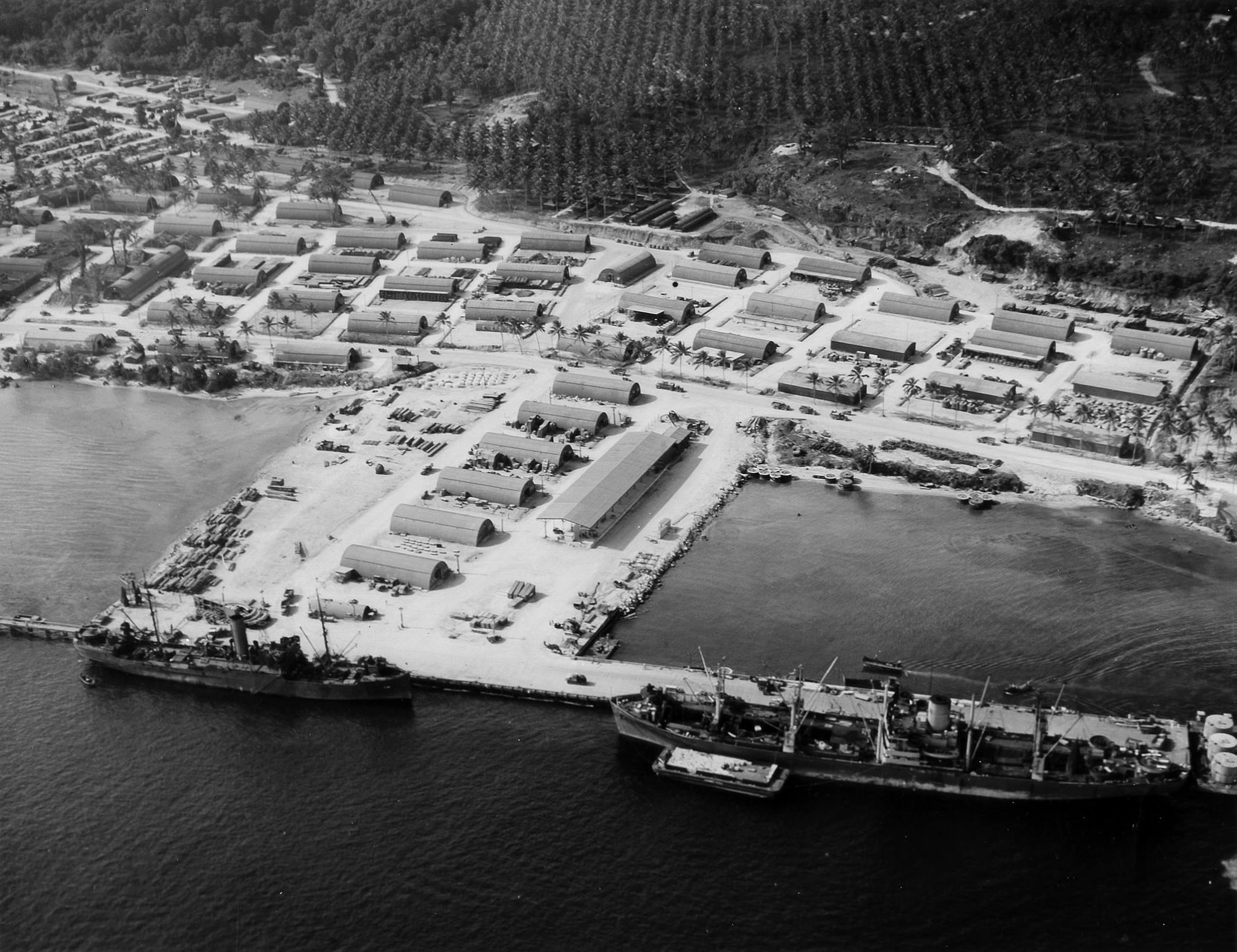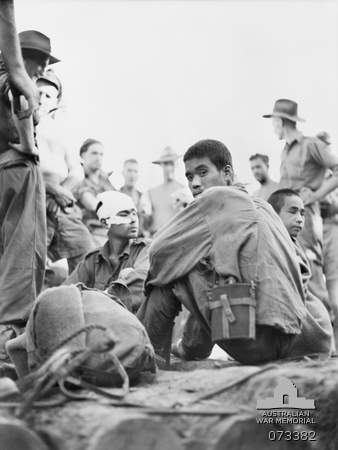|
Naval Base Alexishafen
Naval Base Alexishafen (Naval Base Alexishafen-Madang) was a United States Navy base built during World War II at Alexishafen, north of the city of Madang in New Guinea. The base was built by the US Navy Seabees starting June 13, 1944 as part of the New Guinea campaign of the Pacific War. The base was built at the request of the Seventh Amphibious Force of the United States Seventh Fleet to support the many boats patrolling the area. The US Navy built a boat repair depot including Auxiliary floating drydocks. The base was closed in January 28, 1945. History In May 1944, the US Navy's 7th Amphibious Force requested a base at Alexishafen to provide repair and logistical support for the many boats operating off the north shores of New Guinea. Alexishafen and Madang were liberated on April 26, 1944, by the Australian Army 30th Battalion in the Battle of Madang. Alexishafen's Bostrem Bay offered excellent fleet anchorage. The US Navy began using Bostrem Bay on April 27, 1944, when ... [...More Info...] [...Related Items...] OR: [Wikipedia] [Google] [Baidu] |
Provinces Of Papua New Guinea
For administrative purposes, Papua New Guinea is divided into administrative divisions Administrative division, administrative unit,Article 3(1). country subdivision, administrative region, subnational entity, constituent state, as well as many similar terms, are generic names for geographical areas into which a particular, ind ... called provinces. There are 22 provincial-level divisions, which include #List of provinces, 20 provinces, the Autonomous Region of Bougainville, and the National Capital District (Papua New Guinea), National Capital District of Port Moresby. In 2009, the National Parliament of Papua New Guinea created two additional provinces, that officially came into being on 17 May 2012. [...More Info...] [...Related Items...] OR: [Wikipedia] [Google] [Baidu] |
Pacific War
The Pacific War, sometimes called the Asia–Pacific War, was the theater of World War II that was fought in Asia, the Pacific Ocean, the Indian Ocean, and Oceania. It was geographically the largest theater of the war, including the vast Pacific Ocean theater, the South West Pacific theater, the Second Sino-Japanese War, and the Soviet–Japanese War. The Second Sino-Japanese War between the Empire of Japan and the Republic of China had been in progress since 7 July 1937, with hostilities dating back as far as 19 September 1931 with the Japanese invasion of Manchuria. However, it is more widely accepted that the Pacific War itself began on 7 December (8 December Japanese time) 1941, when the Japanese simultaneously invaded Thailand, attacked the British colonies of Malaya, Singapore, and Hong Kong as well as the United States military and naval bases in Hawaii, Wake Island, Guam, and the Philippines. The Pacific War saw the Allies pitted against Japan, the latter ai ... [...More Info...] [...Related Items...] OR: [Wikipedia] [Google] [Baidu] |
Auxiliary Floating Drydock
An auxiliary floating drydock is a type of US Navy floating dry dock. Floating dry docks are able to submerge underwater and to be placed under a ship in need of repair below the water line. Water is then pumped out of the floating dry dock, raising the ship out of the water. The ship becomes blocked on the deck of the floating dry dock for repair. Most floating dry docks have no engine and are towed by tugboats to their destinations. Floating dry docks come in different sizes to accommodate varying ship sizes, while large floating dry docks come in sections and can be combined to increase their size and lift power. Ballast pontoon tanks are flooded with water to submerge or pumped dry to raise the ship. World War II At the start of World War II, the US Navy had only three steel auxiliary floating dry docks: To reduce travel time for repair work, over 150 auxiliary floating dry docks of different sizes were built during World War II between 1942 and 1945. These newly built f ... [...More Info...] [...Related Items...] OR: [Wikipedia] [Google] [Baidu] |
Royal Australian Air Force
"Through Adversity to the Stars" , colours = , colours_label = , march = , mascot = , anniversaries = RAAF Anniversary Commemoration – 31 March , equipment = , equipment_label = , battles = * Second World War * Berlin Airlift * Korean War * Malayan Emergency * Indonesia–Malaysia Confrontation * Vietnam War * Operation Astute, East Timor * War in Afghanistan (2001–present), War in Afghanistan * Iraq War * American-led intervention in Iraq (2014–present), Military intervention against ISIL , decorations = , battle_honours = , battle_honours_label = , flying_hours = , website = , commander1 = Governor-General of Australia, Governor-General David Hurley as representative of Charles III as Monarchy ... [...More Info...] [...Related Items...] OR: [Wikipedia] [Google] [Baidu] |
Royal Australian Navy
The Royal Australian Navy (RAN) is the principal naval force of the Australian Defence Force (ADF). The professional head of the RAN is Chief of Navy (CN) Vice Admiral Mark Hammond AM, RAN. CN is also jointly responsible to the Minister of Defence (MINDEF) and the Chief of Defence Force (CDF). The Department of Defence as part of the Australian Public Service administers the ADF. Formed in 1901, as the Commonwealth Naval Forces (CNF), through the amalgamation of the colonial navies of Australia following the federation of Australia. Although it was originally intended for local defence, it became increasingly responsible for regional defence as the British Empire started to diminish its influence in the South Pacific. The Royal Australian Navy was initially a green-water navy, and where the Royal Navy provided a blue-water force to the Australian Squadron, which the Australian and New Zealand governments helped to fund, and that was assigned to the Australia Station. Thi ... [...More Info...] [...Related Items...] OR: [Wikipedia] [Google] [Baidu] |
US Naval Advance Bases
US Naval Advance Bases were built globally by the United States Navy during World War 2, World War II to support and project U.S. naval operations world-wide. A few were built on Allies of World War II, allied soil, but most were captured enemy facilities or completely new. Advance bases provided the fleet with support to keep ships tactically available with repair and supply depots of facilities, rather than return them to CONUS, continental United States. Before Japan declared war on the United States the US Navy had a single fleet sized advanced base in the Territory of Hawaii. It was Naval Station Pearl Harbor. During the war the US Navy Seabees built over 400 advance bases categorized by size. Naval bases were either Lions or Cubs while airfields were either Oaks or Acorns. Lions and Oaks were major facilities while Cubs and Acorns were minor. PT Boats typically would get a Cub and airfields with single runways were Acorns. The larger bases could do refueling and overha ... [...More Info...] [...Related Items...] OR: [Wikipedia] [Google] [Baidu] |
Seaplane
A seaplane is a powered fixed-wing aircraft capable of takeoff, taking off and water landing, landing (alighting) on water.Gunston, "The Cambridge Aerospace Dictionary", 2009. Seaplanes are usually divided into two categories based on their technological characteristics: floatplanes and flying boats; the latter are generally far larger and can carry far more. Seaplanes that can also take off and land on airfields are in a subclass called amphibious aircraft, or amphibians. Seaplanes were sometimes called ''hydroplanes'', but currently this term applies instead to Hydroplane (boat), motor-powered watercraft that use the technique of Planing (boat), hydrodynamic lift to skim the surface of water when running at speed. The use of seaplanes gradually tapered off after World War II, partially because of the investments in airports during the war but mainly because landplanes were less constrained by weather conditions that could result in sea states being too high to operate seaplan ... [...More Info...] [...Related Items...] OR: [Wikipedia] [Google] [Baidu] |
Madang Airfield
Madang Airport , is an airport located in Madang, Papua New Guinea. Airlines and destinations History World War II During World War II, occupied by the Imperial Japanese Army in January 1943, as a forward operating airfield for aircraft based at Wewak. Later expanded to a 3250' x 240' runway with a single taxiway with 31 revetment areas. Bombed by the allies during late 1943 and early 1944 the airfield became unserviceable. Imperial Japanese Army Air Force Units at Madang Imperial Japanese Army Air Force *59th Sentai (Nakajima Ki-43 Oscar) *68th Sentai (Kawasaki Ki-61 Tony) *248th Sentai (Nakajima Ki-43-III Oscar) Allied Liberation Liberated by Australian Army forces on 24 April 1944. A large amount of high octane fuel was captured and used by the Australians for use in the Royal Australian Navy motor launch boats. The airfield was repaired and used by the Royal Australian Air Force until the end of the war. Post WW2 in 1947, the Department of Civil Aviation sent an airport ... [...More Info...] [...Related Items...] OR: [Wikipedia] [Google] [Baidu] |
Naval Base Milne Bay
Naval Base Milne Bay, also called Naval Advance Base Milne Bay, was new major United States Navy sea and airbase base built on Milne Bay in Milne Bay Province in south-eastern Papua New Guinea. By spring 1943, the build up of the US Navy to support the Pacific War had caused overcrowding at the ports on the east coast of Australia. To help the Seabee departed Naval Base Brisbane on June 19, 1943 to set up a new base in Milne Bay. Naval Base Milne Bay headquarters was at Ladava Navy Base. The Royal Australian Navy already had a small base in Milne Bay: HMAS Ladava. Australians were able to defend and keep Milne Bay in the Battle of Milne Bay in 1942. Naval Base Milne Bay was built during World War II to support the many ships and aircraft fighting and patrolling in the South West Pacific theatre of war. Ladava Navy Base provided a large protective US Navy fleet anchorage at Gahora Bay next to Ladava. At Naval Base Milne Bay Seabee built large Naval facility. History Nava ... [...More Info...] [...Related Items...] OR: [Wikipedia] [Google] [Baidu] |
Naval Base Finschhafen
Naval Base Finschhafen was a United States Navy base built during World War II at Finschhafen on the Huon Peninsula in Morobe Province of Papua New Guinea. The US Navy built a PT boat base, Dreger Harbor PT Boat Base, boat repair depot, and harbor facilities at Dreger Harbour and Langemak Bay to support the Pacific War in 1943. Harbor was also built to support the US Navy in building 6,000-foot Finschafen Airfield, also called Dreger Field, now Finschhafen Airport on the island. The base was part of the New Guinea campaign. History The Imperial Japanese Army took over Finschhafen on March 10, 1942 in the Battle of Finschhafen and the Landing at Scarlet Beach. On October 2, 1943, the Australian Forces recaptured Finschhafen in the Huon Peninsula campaign. On November 2, 1943, members of the US Navy's Seabee 60th Construction Battalion arrived to start work on the Naval Base. The members of the 60th Construction Battalion arrived from Naval Base Woodlark Island, where most work ... [...More Info...] [...Related Items...] OR: [Wikipedia] [Google] [Baidu] |
Destroyer
In naval terminology, a destroyer is a fast, manoeuvrable, long-endurance warship intended to escort larger vessels in a fleet, convoy or battle group and defend them against powerful short range attackers. They were originally developed in 1885 by Fernando Villaamil for the Spanish NavySmith, Charles Edgar: ''A short history of naval and marine engineering.'' Babcock & Wilcox, ltd. at the University Press, 1937, page 263 as a defense against torpedo boats, and by the time of the Russo-Japanese War in 1904, these "torpedo boat destroyers" (TBDs) were "large, swift, and powerfully armed torpedo boats designed to destroy other torpedo boats". Although the term "destroyer" had been used interchangeably with "TBD" and "torpedo boat destroyer" by navies since 1892, the term "torpedo boat destroyer" had been generally shortened to simply "destroyer" by nearly all navies by the First World War. Before World War II, destroyers were light vessels with little endurance for unattended o ... [...More Info...] [...Related Items...] OR: [Wikipedia] [Google] [Baidu] |
Battle Of Madang
The Battle of Madang, fought between early February and late April 1944, was the Breakout (military), break-out and Breakthrough (military), pursuit phase of the Markham and Ramu Valley – Finisterre Range campaign, Markham and Ramu Valley – Finisterre Range and Huon Peninsula campaigns, which were part of the wider New Guinea campaign of World War II. After overcoming the Japanese defences around Battle of Shaggy Ridge, Shaggy Ridge, the Australian forces descended the steep slopes of the Finisterre Range and pursued the withdrawing Japanese towards Bogadjim and then Madang on the north coast of New Guinea. There they linked up with US and Australian forces that had advanced along the coast from the Huon Peninsula, while the remnants of three Japanese divisions withdrew towards Wewak, where further fighting would take place throughout late 1944 and into 1945. Background Geography Situated on the north-eastern coast of Papua New Guinea on the Schering Peninsula, ... [...More Info...] [...Related Items...] OR: [Wikipedia] [Google] [Baidu] |







